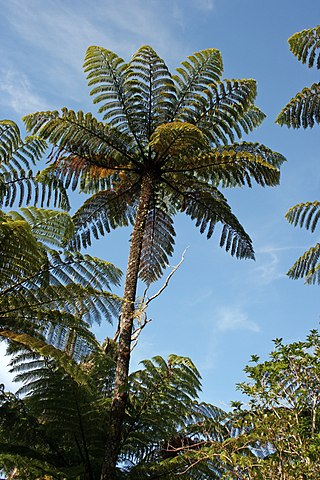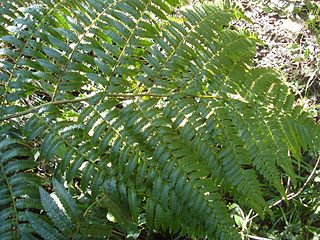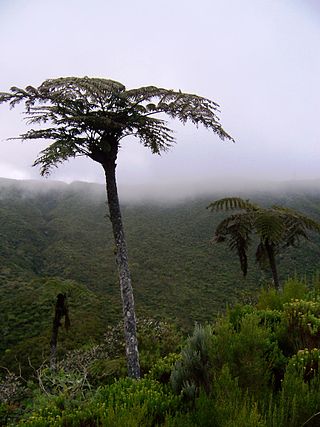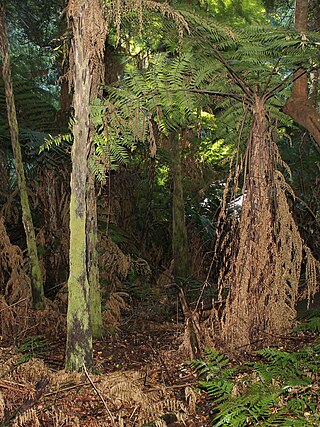
Cyathea is a genus of tree ferns, the type genus of the fern order Cyatheales.

Sphaeropteris medullaris, synonym Cyathea medullaris, commonly known as mamaku or black tree fern, is a large tree fern up to 20 m tall. It is distributed across the south-west Pacific from Fiji to Pitcairn Island. Its other Māori names include katātā, kōrau, or pītau.

Cyathea affinis is a variable species of tree fern native to Fiji, Samoa, the Cook Islands, Austral Islands, Tahiti, and the Marquesas Islands. The trunk of this plant is erect and 2–6 m tall. Fronds are bipinnate and 2–3 m in length. The rachis and stipe are pale to brown in colour, or flushed with red towards the pinnule rachis. The stipe is sparsely covered in narrow basal scales, which are pale to dark and have broad fragile edges. Characteristically of this species, the lowest one or two pairs of pinnae may be slightly reduced and occur towards the base of the stipe. Sori are located near the pinnule midvein and are partially or fully covered by indusia, which open towards the pinnule margin.
Alsophila biformis, synonym Cyathea biformis, is a species of tree fern native to New Guinea and the Maluku Islands, where it grows against trees in mossy forest and rain forest at an altitude of 850–2200 m. The climbing trunk is very thin, only 1–2 cm in diameter, but can reach 3 m in height. The apex of the trunk is covered in scales. Two types of fronds are produced, simple pinnate fronds, which are sterile, and bipinnate fronds, which may be fertile. The stipe is smooth, glossy and very dark, almost to the point of being black. It is covered at the base with long, very dark scales that have a pale margin. Fertile pinnules are distinctly stalked and lobed. Sori occur in four pairs per pinnule lobe and lack indusia.
Alsophila buennemeijeri, synonym Cyathea buennemeijeri, is a species of tree fern endemic to the Natuna Islands in Indonesia. In the World Geographical Scheme for Recording Plant Distributions, these islands are treated as part of Kalimantan. A. buennemeijeri grows in open scrub at an altitude of about 600 m. This rare species is known only from the summits of two low hills. The trunk is erect and may be 5 m tall or more. Fronds are bi- or tripinnate and 2–3 m long. The stipe is dark and covered with spines at the base, as well as numerous scattered dark scales with pale, fragile edges. Sori occur near the midvein of fertile pinnules and are covered by thin, fragile indusia that resemble cups in shape.
Cyathea aristata is a species of fern in the family Cyatheaceae, native to Mexico and Colombia. It was first described by Domin in 1930.
Alsophila hermannii, synonym Cyathea christiiCopel., is a species of tree fern endemic to Mindanao in the Philippines, where it grows in forest at an altitude of 900–1800 m. The trunk is erect and may be 5 m tall or more. Fronds are bi- or tripinnate and 2–3 m long. The stipe is covered with some warts and narrow, brown scales. Sori occur near the midvein of fertile pinnules and are covered by thin, fragile indusia.
Cyathea decora is a species of tree fern native to Ecuador and possibly other parts of western South America. Little is known about this species. The name is the source of some taxonomic confusion: as of July 2021, Plants of the World Online regarded "Cyathea decora" as an unplaced name, and it was not listed at all in World Ferns.
Cyathea feeana is a species of fern in the family Cyatheaceae, native to Southeast Brazil. It was first described by Carl Frederik Albert Christensen in 1905 as Alsophila feeana.
Alsophila costalisora, synonym Cyathea costalisora, is a species of tree fern native to western New Guinea, where it grows on the edges of forest and in moist hollows at an altitude of 1900–3225 m. The trunk is erect, up to 4 m tall and may branch near the base. Fronds are bi- or tripinnate and 1–1.5 m long. The stipe is warty, especially where scales have fallen. The scales are pale and have a distinctive dark glossy central region, with a paler dull margin. Sori are round and occur near the fertile pinnule midvein. They are covered by firm, dark indusia that are cup-like in appearance.
Alsophila jimeneziana, synonym Cyathea crassa, is a species of tree fern endemic to the Dominican Republic. Little is known about this rare tree fern.

Alsophila cunninghamii, synonym Cyathea cunninghamii, also known as the gully tree fern and slender tree fern, is a species of tree fern indigenous to New Zealand including North Island, South Island and Chatham Islands; also to Victoria, possibly New South Wales, southeastern Queensland and Tasmania in Australia. It grows in damp forest, often emerging from stream gullies and riverbanks. Brownsey noted that it has a lower tolerance for drought than other related species. The erect trunk may be 20 m tall and is usually 6–15 cm in diameter, occasionally as much as 20 cm. Fronds are tri- to tetrapinnate and 3 m or more in length. The rachis and stipe are slender, black brown, warty and covered with brown scales. Sori occur along each side of the pinnule midvein and are covered by hood-like indusia. A. cunninghamii is an uncommon and slow-growing tree fern.
Alsophila dryopteroides, synonym Cyathea dryopteroides, is a tree fern native to Puerto Rico, where it grows where it grows in shaded areas and cloud forest at an altitude of 1000–1200 m. The erect trunk may be 1.3 m tall and approximately 5 cm in diameter. Fronds are pinnate and up to 1.6 m long. The rachis is often purplish brown and covered with scales, usually on the underside. The scales range in colour from golden brown to bicoloured. Sori occur along each side of the pinnule midvein and indusia are cup-like.
Cyathea biliranensis is a species of fern in the family Cyatheaceae, native to the Philippines. It was first described by Edwin Copeland in 1955.

Cyathea delgadii is a widespread species of tree fern. It is native to Central America, and much of South America. The specific epithet delgadii refers to Gancho do Generale Delgado, along the road to Caldas Novas, Brazil, where the type material was collected.

Alsophila is a genus of tree ferns in the family Cyatheaceae. It has also been considered to be a section in the subgenus Cyathea of the genus Cyathea.

Cyathea is a section in the subgenus Cyathea.

Alsophila glaucifolia, synonym Cyathea glauca, is a species of tree fern endemic to Réunion. Little is known about this species.
Cyathea obtusa is a species of fern in the family Cyatheaceae, native to Trinidad and Tobago, Venezuela, and the Windward Islands. It was first described by Domin in 1929.

Alsophila leichhardtiana, synonym Cyathea leichhardtiana, the prickly tree fern, is a plant in the tree fern family, Cyatheaceae, found in eastern Australia. It is a common species found in moist situations, in and near rainforests. It was named in honour of the explorer and botanical collector Ludwig Leichhardt.







